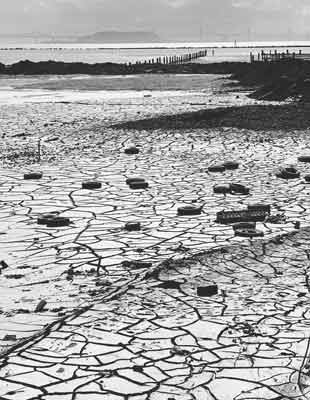The Natural World
At East/West Gallery. Shows through May 31.

Traces of human influence on the natural world have long been a subject of interest to photographers. In 1975, William Jenkins curated an exhibition titled New Topographics: Photographs of a Man-Altered Landscape, and the movement of documenting impacted environments was born. Jenkins’s show spawned a new generation of landscape photographers for whom evidence of human presence on the land was central to their work. Now on exhibit at East/West Gallery, The Natural World draws together the work of four such photographers, each with a distinctive vision of a land impacted.
Stephen Harrison presents three color images from his series of digitally enhanced works, Visualizing Earth. “Tornado House” depicts a rustic home that is being dwarfed by the fury of an approaching tornado. In “Fa§ade,” office workers appear ant-like in the shadow of a towering concrete building. Of all the works in the show, Harrison’s “Cleaved Glacier,” which depicts a cracked iceberg floating in an open sea, speaks most subtly and most hauntingly of environmental devastation, here in the shape of global warming. In this trio of works, Harrison gives us insight into the shifting relationship between humans and nature, and the impact each can exert on the other.
Christina Seely’s three large-format color images portray nighttime cityscapes from three of the most light-polluted regions of the world. Images of Boston, Tokyo, and Paris represent North America, Asia, and Western Europe respectively. Glowing night lights are typically looked upon in wonder, but here Seely deftly conveys not only their inherent beauty, but also the intrusion the ethereal glow makes on the surrounding environment.
While Seely works under the cloak of darkness, Daniel Disipio embraces light’s harsh extremes. His poetically washed-out images of desolate landscapes littered with decaying cabins, abandoned gas stations, and tilting towers conjure a sense of a modern wasteland. Rounding out the exhibition is Rondal Partridge, whose collection of Californian images speaks eloquently of the changes wrought on familiar ground. A congested Yosemite parking lot stretches out beneath Half Dome, sensual rolling hills are scarred by a road, and the cracking mud flats of a Bay Area estuary are littered with car tires. In each case, the drama of these spare scenes is furthered by the classic black-and-white presentation.
As our impact on the landscape continues to grow, photographs such as these become increasingly valuable records of the world around us and poignant commentaries on the ways in which human civilization affects our environment.



